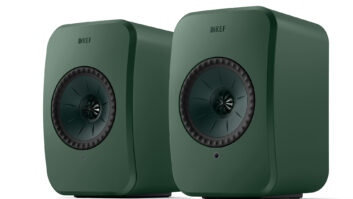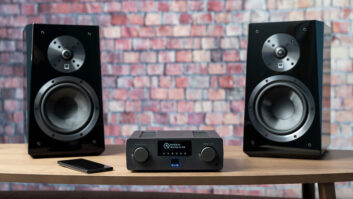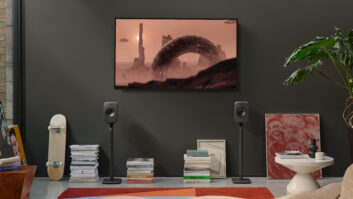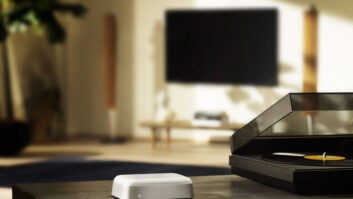Peruse the pages of more mainstream consumer electronics publications (or ask any of my female friends), and you’d swear that the most despicable contraption every cobbled together by man in the pursuit of progress isn’t the internal combustion engine or the atomic bomb, but rather the lowly wire.
Read anything written about cables and interconnects in the past decade (barring the esoteric ramblings of audiophiles), and you have to assume that when future wire-free civilizations stumble across our literature, they’ll come to the conclusion that “hassle” is simply the collective noun for the groups in which wires naturally congregate, like a litter of puppies or a murder of crows–“the hassle of wires.”

IOGEAR’s AVIOR Series Wireless HD Kit
And so, with subsonic frequencies and ambient sounds already having made the leap to cable-free transmission thanks to the steady stream of wireless subwoofers and surround speaker solutions on the market, it’s no great shock to see a number of companies now offering wireless HD audio-video systems to eliminate the need for long, unsightly runs of that most loathed of all interconnects: the HDMI cable.
IOGEAR’s AVIOR Series Wireless HD Kit is the first such system I’ve had a chance to spend any quality time with, so I can’t offer much in the way of objective comparison to similar systems, but judged on its own merits, the Wireless HD Kit does what it promises to do, and does it well.
The only problem I’ve had with the system since it arrived has been figuring out how to use the thing. And by that I don’t mean that it’s difficult to operate; it’s exceedingly easy. I simply mean that after unboxing the transmitter and receiver and pouring over the very straightforward instructions, I sort of wandered around my house for a few days fretting over the best way to put the Kit to good use.
With deadlines looming and reviews refusing to write themselves, I eventually decided to disconnect my OPPO Blu-ray player in the media room and beam its signal wirelessly to my display (which, in the interest of full disclosure, is a mere six feet away, but I remind you that a certain celebrated flight in Kitty Hawk only lasted 12 seconds and 120 feet. Baby steps. Work with me here).
Honestly, it would take you longer to read about the setup process than it took me to do it. But the gist is this: plug your source component(s) into the wireless transmitter (which boasts two HDMI inputs; composite AV ins; a VGA port, which doubles as a composite video input with the included VGA-tocomposite dongle; a mini-jack for PC audio input, and an IR output), connect your display or sound processor to the wireless receiver (via HDMI, donglefree component, or composite, with mini-jacks for audio output and IR input, as well), power it all up in the right order (this is critical the first time out), and within a few minutes, you’re living in the Wireless Future. Just like that, in capital letters and everything.
Okay, so technically there is a bit of irony in the fact that hooking up the Wireless HD Kit necessitates a doubling of the number of wires in your system. But they’re shorter wires, right?
Yeah, maybe not if you’re only running it a grand total of six feet. But at least the short run gave me a chance to evaluate the video performance of my system with the Wireless Kit in place, which turned out to be very close to its performance in old-school wired mode. The image still looked great, even with full 1080p/60 Blu-ray video. Digital Video Essentials Blu-ray test patterns? Not exactly flawless, but much better than expected.
Still, though, six feet, right? I felt a bit like a magician pulling a stray hair out a magical hat and expecting applause. That’s when inspiration struck, and I figured out a way to put not only the Wireless HD Kit’s multiroom capabilities, but also its VGA input, to better use. And within mere minutes of said inspirational strike, I had my office PC set up for dual-monitor output, with Windows Media Center running on the second monitor (and by “second monitor,” I mean the Samsung LCD TV hanging on the wall in the bedroom), complete with full surround sound output via the wireless receiver’s HDMI output and complete second-zone control thanks to the Kit’s IR ins and outs and what-have-yous. It was like having a second, standalone Media Center PC running in the bedroom, just without the extra expense.
Well, sure, there’s the expense of the Wireless HD Kit itself, which at nearly $900 is not insignificant. (You can also buy up to three additional wireless receivers for $300 or so each). But for large retrofit installations where aesthetics are top priority and in-wall wire runs are impossible, IOGEAR’s Wireless HD Kit, price probably isn’t going to be a huge concern.
866.946.4327 www.avior.iogear.com
Kudos
IOGEAR ’s AVIOR Series Wireless HD Kit boasts simple plug-and-play installation and very good wireless performance with little signal degradation.
Concerns
The transmitter and receiver run hotter than a stolen habanero pepper, and with manufacturer-supported wireless HD standards looming on the horizon, the system may have a rather limited shelf-life.
Product Specs
■ Transmitter Video Input: 2 x HDMI , 1 x Composite, 1 x VGA
■ Receiver Video Output: 1 x HDMI , 1 x Composite, 1 x YPbPr Component
■ LAN : 1 x LAN Port (Transmitter and Receiver)
■ Audio Input: 1 x 3.5mm Audio Jack (Transmitter)
■ Audio Output: 1 x 3.5mm Audio Jack (Receiver)
■ Video Resolution: 480i/p, 720p, 1080i and 1080p (24/30/60fps)
■ Video Streaming: <30ms Latency
■ Frequency: 5.15~5.25GHz
■ Range: 100ft (30m)





